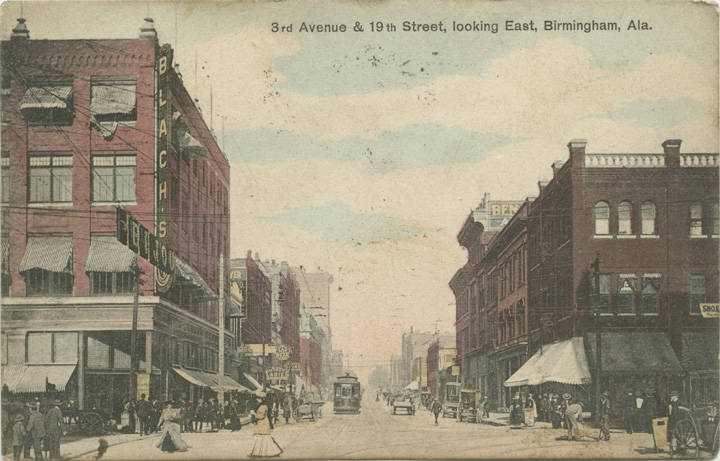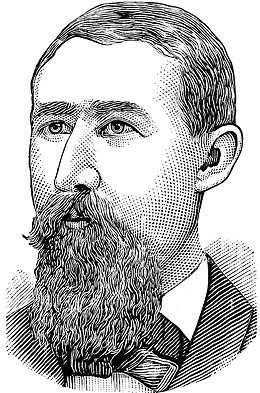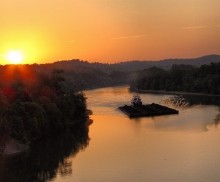Over the years there has been considerable talk that Birmingham, Alabama sits over a large underground stream. It is reported that early settlers of Birmingham were told by the Native Americans that an underground river ran the full length of Jefferson county and often spoke of traveling down the stream in a canoe from the Warrior River.
When new buildings were being constructed in Birmingham in the 1880s, there were numerous reports of people encountering this underground stream, but none would ever top the report made by a visitor named Prof. Joseph Mulhattan.
Professor Mulhatton/Mulhattan
Joesph Mulhatton/Mulhattan was connected with various papers that kept the public aware of new inventions. One day on a visit to Birmingham in 1883, he read with interest an article in a Birmingham newspaper a story about some men who were engaged in boring an artesian well in town and had encountered an underground stream. It seems they had struck what seemed to be a small flowing stream of water at a depth of three hundred feet. Shortly afterward, the following thrilling story by Mulhatton appeared in the Louisville Courier-Journal to the effect that “an immense underground river flowed under Birmingham, Alabama, and the entire town was in danger of falling in and being swept away. While excavating for the foundation of a large building, the stone crust that supported the few feet of earth above the river had been pierced, and it was breaking and giving way all over the city. Several buildings had fallen down, and one corner of the City Hall had settled four feet into a fissure which was rapidly widening, and soon the entire building would go down into the dark, underground river.”
The story made an immense sensation when it was printed. For two days the telegraph-office at Birmingham was flooded with telegrams from all parts of the country, asking if there was any truth to the story.
In the Birmingham newspaper the Weekly Iron Age of 8/28/1884, the following article appeared:
The Great Kentucky Scientist and Cave Expert Gives His Impressions of Our Subterranean River
To The Age:
The discovery of the great subterranean river under Birmingham has been the great topic of conversation the past week. Great excitement has prevailed, and so great was the interest taken in it the Dr. Jos. R. Smith, W. S. Brown, Wm. Hood, T. J. Brown, Wm. Berney, Geo. C. Kelly, J. B. Earle and other leading citizens held a meeting at which it was decided to telegraph Prof. Joseph Mulhatton, the great scientist and cave expert the facts in the case and urge him to come at once to give it a thorough exploration. The result was that Prof. Mulhatton arrived from Louisville on Friday evening, and a party composed of the above-named gentlemen spent all day Saturday exploring the great subterranean wonder.
Strong boat was made to explore cave
A strong boat was quickly improvised in the cave from lumber which was lowered through the narrow inlet and the party proceeded down the river for at least fifteen miles before there was any obstruction to prevent them from going forward, and that was only a narrow formation of recent origin that can be easily cleared away. The natural tunnel through which the river flows is of almost uniform width, and say about 300 feet for the distance of the fifteen miles navigated, and the height is at least 150 feet, so that a steamship of the largest class could navigate it with ease; the depth of the stream varies from 45 to 70 feet. It is connected with tide water, and this will give Birmingham a wonderful and cheap outlet to the sea, for the products of its furnaces, its mines, and industries generally.
The above is Mr. Mulhatton’s first impression of the wonder, which is fully corroborated by all of his party of daring explorers. But this is not all Prof. Mulhatton has this to say about it: “The great subterranean river recently discovered under the city of Birmingham is undoubtedly the most remarkable discovery ever made on the American continent. The river is greater in volume than the mighty Mississippi. Its vast subterranean bed is undoubtedly due to the grinding and cutting of immense icebergs during the glacial period. Then at a subsequent Preadamite period violent upheavals of the earth toppled over the mountains which forms the present grand archway through which the icebergs continued to cut leaving it as it is now—a natural ship canal to the Gulf of Mexico. A prehistoric race undoubtedly utilized it for the transportation of metals from this section to the sea where they were transported to various parts of the world. Furnaces on a scale scarcely so magnificent yet as satisfactory in results to these prehistoric people undoubtedly existed on the present site of Birmingham, as ruins of these, and of ancient sun-temples are found in various parts of this county.”
“Added to this,, ” says Professor Mulhatton, “we discovered niches of the cave numerous articles of bronze, also statuary, numerous masonic emblems, and mummies with sandals on their feet—all in a perfect state of preservation. We also discovered the remains of many marine monsters of the dias or old red sandstone period, prominent among them the huge ICHTHYOSAURUS, which was undoubtedly used by these pre-historic races to drag their ships from what is now Birmingham to the Gulf of Mexico. These extinct sea monsters were docile and harmle and were harnessed to the ships laden with pig iron, which they pulled to the sea with the greatest of ease. They were more powerful than the most powerful locomotives of the present day. Hulls of these ancient ships are scattered all along the banks of this great subterranean stream.”
Further explorations will be made today by Prof. Mulhatton and his scientific party; and their next report will be eagerly looked for by the readers of the AGE as the wildest excitement now prevails over these latest developments. Thousands of people have been crowding around the entrance to the river clamoring for admission. Prof. Mulhatton saw numerous eyeless fist and eyeless sea-monsters of the shark species; also eyeless amphibious animals of the alligator and reptile tribe. He says a company should be formed at once to clear the river of any obstructions, and that boats and barges to navigate it should be constructed at once. As the entrance to it is on one of the streets of the city, it will, therefore, belong to the city and cannot be claimed by any private individuals.
This discovery is of paramount importance to Birmingham, to Alabama and to the entire scientific world, and is worthy of the greatest enthusiasm.
Newspaper discovered Mulhatton told lies
By October 16, 1884, the Weekly Iron Age realized they had been ‘taken in’ by Mulhatton’s wild story and it was full of lies. The following article appeared in the newspaper.
The October 16, 1884, edition of the Weekly Iron Age wrote quite a different story about Prof. Joe Mulhatton from the Louisville Courier-Journal. At the time Mulhatton was nominated for president by the drummers’ national convention, held in Louisville, Kentucky. The news article calls Mulhatton the greatest living romancer and one of the ‘Most Genial”, but clearly states that he was a liar. Rather than being a Professor and a scientist, he was a drummer. In explaining his wild stories to a reporter, Mulhatton said, “People haven’t time to read books now-a-days, yet they must be entertained from the newspapers. So I write short novels of the Jules Verne order and they are talked about everywhere. I never do any harm by my stories—any harm, you known, and I write for the amusement of myself and others—for amusement.”
Joseph Mulhatton became known as the richest, most popular, and best commercial traveler in the United States as well as a champion liar. Sadly, later in life, Mulhatton became an alcoholic and in 1891, he was placed in a Chicago detention hospital for the insane because of his drunkenness. His health continued to decline after he was released and he died in Kelvin, Arkansas in 1914.
Rumors persisted
However, reports of an underground stream under the city of Birmingham continued to persist and there may be some truth to the rumor. After a flood on April 1, 1886, the Weekly Iron Age reported that early settlers of Birmingham remembered a spring on the corner of where 4th and 20th street. Also, in the center of the street where 2nd and 21st intersect that a deep well suddenly went dry. It was reported that a business man went to the well for water and the bucket was dry because the bottom dropped out of the well, supposedly due to the underground river.
 1st Ave. West from 21st St. showing Brown-Marx building postcard 1908 (Alabama Department of Archives and History)
1st Ave. West from 21st St. showing Brown-Marx building postcard 1908 (Alabama Department of Archives and History)
An October 22, 1885, edition of the Weekly Iron Age reported that George Stonestreet, a sewer contractor, reported having been asked where the “big stream” was while his crew was working below 1st Avenue. Stonestreet replied that he “had not discovered it myself yet.” He further explained that the lowest section of the city was the “flats below the Coketon Depot, and the highest point was “near the exposition building on 20th Street.”
Another report similar to Mulhattan’s earlier efforts appeared in the May 29, 1886, edition of the Birmingham Age, “under the cryptic byline “H”. It told the story of a covert voyage in a stolen boat under the city, the discovery of Steve Renfro’s hidden counterfeiting operation, and of eventually surfacing into the Warrior River in Tuscaloosa. The group supposedly continued as far as Tuscaloosa where they spent the night before taking a train back to Birmingham. The entrance at Avondale Park was sealed in the 1930s but re-discovered later. A group of trained spelunkers mapped as much of the flooded cavern as they could in 1983, finding most of the passages disappearing quickly into mud-filled crevices.”
 The Lagoon at Avondale Park 1930s (Alabama Department of Archives and History)
The Lagoon at Avondale Park 1930s (Alabama Department of Archives and History)
According to Bham Wiki, “There are numerous references, some fictional, some not, to an underground river flowing beneath downtown Birmingham. UAB geology instructor George Brockman attested to the presence of a below-ground stream downtown.” The floor of Jones Valley, like much of the Birmingham District, consists primarily of limestone karsts. Limestone is a relatively soft sedimentary rock which is easily worn and shaped by eons of water flow. Slightly acidic runoff can accelerate the formation of caverns which become sinkholes when they collapse.
Reports of this underground river still persist. A sinkhole, reportedly more than 100 feet deep, appeared near the intersection of 15th Street and 3rd Avenue South during the construction of Regions Field and a proposal to construct a pedestrian tunnel under 10th Street South connecting the Alys Stephens Center to the Abroms-Engel Institute for the Visual Arts was abandoned because “a river bed flows under the street.”
SOURCES
- Wikipedia
- Bham Wiki
- Alabama Department Archives and History
- Weekly Iron Age
Read more lost stories in Alabama Footprints Confrontation- a collection of lost and forgotten stories that reveals why and how the confrontation between the Native American population and settlers developed into the Creek-Indian War as well as stories of the bravery and heroism of participants from both sides.
Some stores include:
- Tecumseh Causes Earthquake
- Terrified Settlers Abandon Farms
- Survivor Stories From Fort Mims Massacre
- Hillabee Massacre
- Threat of Starvation Men Turn To Mutiny
- Red Eagle After The War





monsters below Birmingham and above it now
You gonna build a General Lee outta that primed up Charger ?? Flag and all would be awesome !!
Smh! God bless you despite your ways.
Doesn’t know me either Chris Brantley…
A bit excessive. Too much information bruh.
Well said Chris
I was told sylacauga was built on a swamp
I live in Sylacauga and we have always heard there is an underground river here as well.
Alot of caves in sylacauga as well
Oh yes. I have explored many here through the years.
I worked in the historic John Hand building for 5 years when it was Superior Bank. We had a water pump in the basement that ran constantly to keep this water out. When Amsouth vacated the building in the early 90’s that pumped was turned off and the water flooded the 1st floor.
I work in another building downtown and several months ago, same thing happened in our building. Pumps stopped working and flooded the subbasement. Water was as clear as natural spring water.
Yep! Everyone always thought it was the AC kicking on but it was the pump. I was always told it was bc of the river beneath.
We were at a Christmas party there a couple of weeks ago. I’m glad I found this out afterward . Lol
When I was young I was at my aunts house in Midfield . On Saturday morning I asked her when the people were going to finish cutting yo the few limbs left og the huge tree in backyard . She ask what I was talking about we went out damn tree was gone down a sinkhole scared the hell out of both of us
Yes there is a river under Birmingham. Had a problem setting pile on for a seven story building downtown due to this river that runs under Birmingham.
I think the Professor is full of baloney.
The photo with the caption, “1st Ave. West from 21st St. showing Brown-Marx building postcard 1908” is incorrect. This is the intersection of 3rd Avenue and 19th Street, looking east along 3rd Avenue. The building on the left foreground is the old Blach’s Department Store building. The building was torn down and replaced by the Kress building (still standing and occupied by a law firm). Most of the other buildings have been torn down, too.
these people were on some powerful drugs
Hopefully city council will be in session when the city falls in. Wash away all the bull shit.
Steel industry needed limestone, the area is loaded with it. It is possible, and I’ve heard these stories too.
One runs under my hometown. It is a Paleo-aquifer.
funny and fascinating !
This a great river for bass fishing
When I was about 13-14 years old I remember my dad telling about a construction site near where he worked that had broken though to this river. The construction company tried to fill the hole but every time they dumped a load of fill into it, the river just washed it away. As I remember they were never able to fill the hole.
Do you remember where it was?
Not really, at the time he was working in the East lake area. So I would guess it was some where between 1st ave and Tarrant.
My Grand Father used to tell me that Birmingham was built on a frog pond, maybe he was right!!
Where? And why hasn’t the city utilized it?
Birmingham has been messed up since 1980 you know what I mean!!!
Drill a big damn hole!!Install power plant!!Maybe the city can make some Money!!!
Not a free flowing “river”, but mud filled voids in the limestone. There was a lake along Powell Ave that has long been filled. There was a lot of trouble getting the piles set for the Daniel Bldg because of voids.
Always believe native americans, just sayin’!
During construction of UAB’s North Pavilion they had flooding issues due to this underground river. This was about 15 years ago.
Pine Mine had 3 lateral tunnels that ran from hwy 150 almost to Oxmoor Rd. The iron ore played out & they began to mine upward for high quality limestone. But this layer supports the ‘river’ you describe which is the potsville formation. They ruptured that seal & so much water poured in the mine that all the could do was to escape. They left 3 locomotives & all equipment there. We attempted to use the mines to dewater the water level to construct a sewer tunnel that wleminated the Shades Creek Sewer Plant and allows the Homewood Hoover areas sewage to flow by gravity to the Valley Creek Wasterwater plant in Bessemer. This was in the mid 80s. A similar project was constructed to eliminate a the Patton Creek plant & divert it’s sewage to the Cahaba River plant. A similar effort was underway to do the same thing in Trussville & Leeds but the Cahaba River Society stopped this one as it might have allowed for expanded development in the Basin.
I had a river running under my house in MB.
In the late 60’s or early 70’s my late father in law said a major construction company, Daniels was building its headquarters and hit water that they were unable to stop or fill. Cost them a lot of money.
History is important information
True or not it’s plain creep.
Rose Ann Haven
Silver lake in pinson. They say it has no bottom. It just runs in to a bigger deeper current running from side to side.
It should have been Monroe County because at that time it was the biggest county of Alabama
Ellen Beidler interesting
It’s true!! We encountered it when Children’s was adding on the building in the 80’s!
This is likely the same underground river that flooded the Ketona strip mine, near Tarrant. It filled up overnight, I am told! The steam shovel and mining equipment is still at the bottom. We used to swim there in the ’50’s and 60’s, until it was fenced off and no trespassing signs posted.
Downtown Birmingham was built on top of the headwaters of Valley Creek, its name derived from Jones Valley, which the city is settled in. Valley Creek — like Village Creek (with headwaters in Roebuck Springs/East Lake) and Five Mile Creek (with headwaters in Clay and flows through Centerpoint & Tarrant right by Ketona Lakes) — is formed by springs which are fed by underground aquifers. These underground freshwater aquifers hold massive amounts of water that course through karst limestone formations in our region.
Over the past one hundred and forty years, developers in downtown Birmingham have many stories about encountering unending amounts of water from below. This is not abnormal – it is the norm. Just ask coal miners and limestone quarry miners… “running into” groundwater is common in the region. Encountering water during construction in Jones Valley should be expected, and most buildings in downtown have massive sump pumps constantly working to de-water their basements. This is what happens when man attempts to restructure a wet natural valley into a developed urban city. Man rarely “wins” in battles against nature… he just finds a way to engineer a relatively short-term workaround.
Valley Creek currently flows underneath the city in a series of concrete and bricks culverts. All of downtown’s curbside storm drains, which accept rain runoff from roofs, sidewalks, parking lots, and streets, feed into this culvert system~ and ultimately flow out into Valley Creek’s open channel at the “Light of Day” just West of downtown & I-65 at 5th Ave. N & 7th St. N.
Over the past 12 years, I have heard many a story about Birmingham’s or JeffCo’s vast underground river from people I have encountered while serving as Black Warrior Riverkeeper. However, this story absolutely tops them all in actual detail – and imagination (clearly, not much of this can be believed). Thank you so much for sharing this story and writing this article! I don’t doubt that explorers have encountered vast chasms of quantities of flowing water underground over the years… that is groundwater, and we have plenty of it!
That data is very interesting! I was wondering about Valley Creek flowing through what’s now downtown Birmingham as the “current” daylight source is really just a culvert opening meaning the headwaters had to be upstream. I was wondering if the springs creating Valley Creek flowed “downhill” from, say Highland Park around Avondale and nearby locations and merged in the level valley. Further north there’s Kings Spring and others creating Village Creek, but that’s in a totally separate watershed that drains the North Birmingham-Finley Boulevard area. So I was wondering if the Avondale area and Woodlawn were some of the sources of the now buried Valley Creek to it’s “daylight” opening. It would be interesting if the probable former upstream route and branches could be mapped!
I have lived in Tarrant most of my life. My mother and grandmother told me about our property having a sinkhole and prior to patching the hole, they could hear a loud sound of rushing waters comung out of the hole. In their effirts to patch the hole, they brought a tree that was swallowed cimpletely by the hole. It took days fir them to figure how to patch it. Still unclear how tgey did it or if the ground us truly safe. They said days of dump trucks one after another from the rock quarry a few blocks away were used to plug the hole.
As for Lake Ketona, I too was told it was filled with overnight and that for a day or two after, rescue divers could see the lights of vehicles burning along the sides of the quarry’s access path. It was believed that the vehicles were caught by the flooding waters before they could race out of the quarry. Nevertheless, My grandparents and mother all agreed it was filled overnight.